#540 Comet Halley's Nucleus
Credit: December 10, 1996
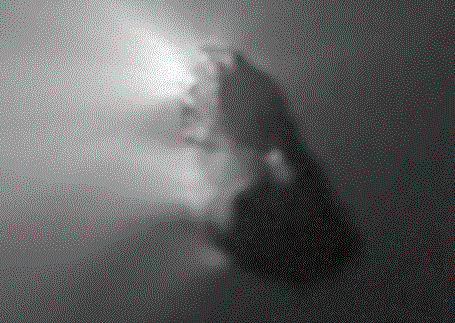
“Here is what a comet nucleus really looks like. For all active comets except Halley, it was only possible to see the surrounding opaque gas cloud called the coma. During Comet Halley's most recent pass through the inner Solar System in 1986, however, spacecraft Giotto was able to go right up to the comet and photograph its nucleus. The above image is a composite of hundreds of these photographs. Although the most famous comet, Halley achieved in 1986 only 1/10th the brightness that Comet Hyakutake did last year, and a similar comparison is likely with next year's pass of Comet Hale-Bopp. Every 76 years Comet Halley comes around again, and each time the nucleus sheds about 6 meters of ice and rock into space. This debris composes Halley's tails and leaves an orbiting trail that, when falling to Earth, are called the Orionids Meteor Shower. "
Copyright: MPAE
#541 Starburst Ring in Galaxy NGC 1317
Credit: December 11, 1996
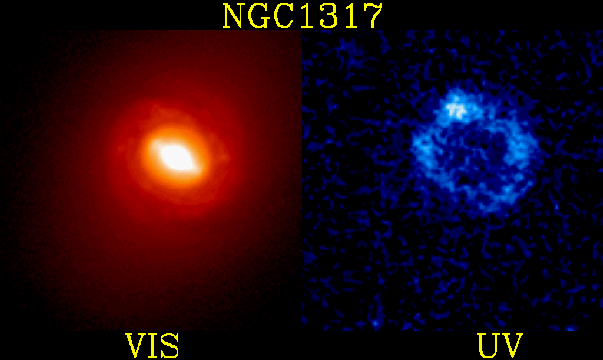
“Where do stars form? A typical place is an area of dense nebular gas common to arms in spiral galaxies. Sometimes, however, a burst of star formation can occur with unusual geometry. Nearby galaxy NGC 1317 shows such an unusual ring of star formation surrounding its barred nucleus. In the above image, older stars appear more red and are more evident in the leftmost photograph in visible light. The rightmost photograph taken by the Ultraviolet Imaging Telescope is in ultraviolet and highlights stars which are younger and bluer and shows the starbirth ring. This unusual ring may be evidence of a gravitational encounter with another galaxy, causing a density wave to ripple out from the galaxy's center. "
Copyright: Public domain
#542 The Milky Way Through the Summer Triangle December 12, 1996
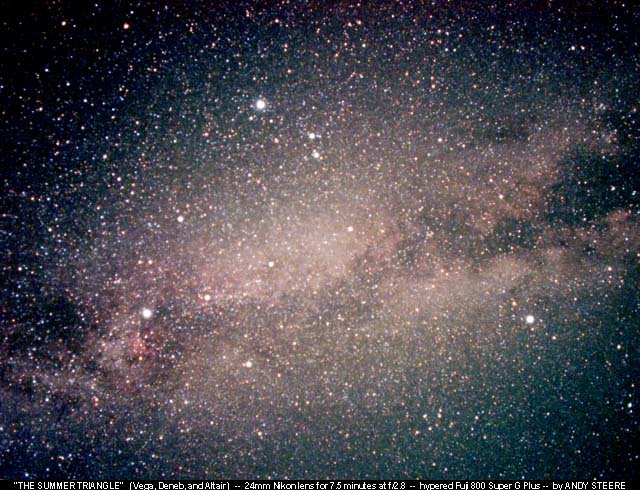
“There are more than a few stars in our Galaxy. The light from many of them combines to appear as a wisp of faint light across the night sky - the Milky Way. In the northern hemisphere, away from city lights and during the summer months, part of the Milky Way can be seen behind the Summer Triangle of stars - Deneb, Vega, and Altair. These are the brightest three stars in the above photograph, listed from left to right, respectively. If you could collect light in your eyes for 10 minutes at a time (instead of the usual 1/10th of a second), you might see something like the above photograph. Behind the Summer Triangle lies some of the vast star fields of our Milky Way Galaxy, containing literally billions of stars. The dark band across the middle that seems to divide the stars is actually interstellar dust, which absorbs more visible light than it emits and so appears dark. "
Copyright: Andy Steere
#543 Disorder in Stephan's Quintet December 13, 1996
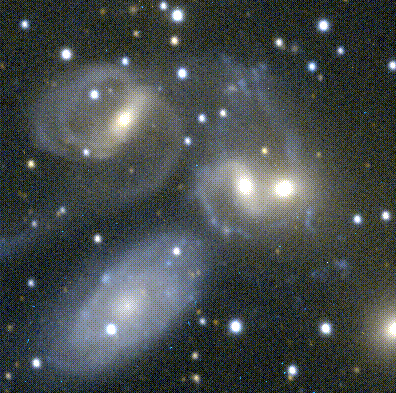
“Five closely grouped galaxies are visible in this image made using the Kitt Peak National Observatory 2.1 meter telescope. The grouping is commonly known as Stephan's Quintet. Four of the galaxies show essentially the same redshift suggesting that they are at the same distance from us. The large bluish spiral below and left of center actually has a smaller redshift than the others, indicating it is much closer. It is probably a foreground object which happens to lie along the line of sight to the more distant galaxies. Of the four distant galaxies, three seem to be colliding, showing serious distortions due to gravitational tidal forces. The fourth is a normal appearing elliptical galaxy (at the lower right edge of the field). Recent results suggest that collisions play an important role in the life cycles of galaxies. "
Copyright: Public domain
#544 Our Solar System from Voyager December 14, 1996
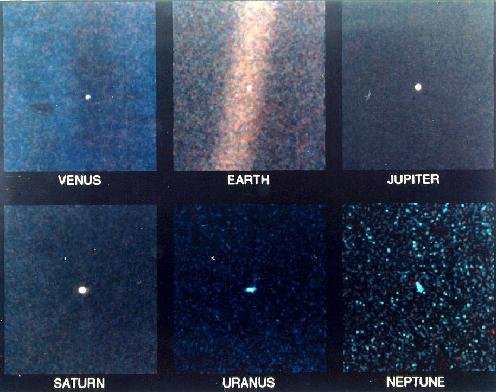
“After taking spectacular pictures of our Solar System's outer planets, Voyager 1 looked back at six planets to take our Solar System's first family portrait. Here Venus, Earth, Jupiter, Saturn, Uranus, and Neptune, were all visible across the sky. Each, however, was now just a small speck of light, dimmer than many of the stars in the sky. Voyager 1 is only one of four human-made objects to leave our Solar System, the other three being Voyager 2, and Pioneer 10 and Pioneer 11. "
Copyright: Public domain
#545 Microlensing of the Einstein Cross December 15, 1996

“The famous "Einstein Cross" is a case where a single object is seen four times. Here a very distant QSO happened to be placed right behind a massive galaxy. The gravitational effect of the galaxy on the distant QSO was similar to the lens effect of an empty wine glass on a distant street light - it created multiple images. But stars in the foreground galaxy have been found to act as gravitational lenses here too! These stars make the images change brightness relative to each other. These brightness changes are visible on these two photographs of the Einstein Cross, taken about 3 years apart. "
Copyright: Public domain
#546 Nebula Nova Cygni Turns On December 16, 1996
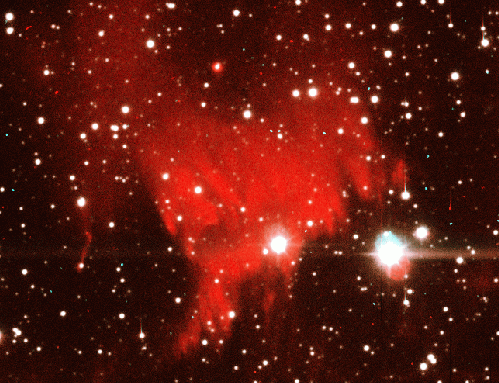
“Old photographs show no evidence of the above nebula. In 1992, a white dwarf star in Cygnus blew off its outer layers in a classical nova explosion: an event called Nova Cygni 1992. Light flooded the local interstellar neighborhood, illuminated this existing gas cloud, excited the existing hydrogen, and hence caused the red emission. The only gas actually expelled by the nova can be seen as a small red ball just above the photograph's center. Eventually, light from the nova shell will fade, and this nebula will again become invisible! "
Copyright: Public domain
#547 Mariner's Mercury December 17, 1996
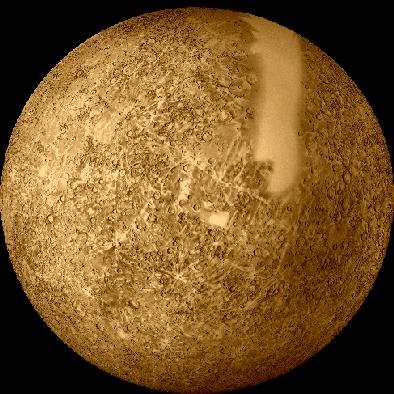
“Mercury, the closest planet to the Sun, remains the most mysterious of the Solar System's inner planets. Hiding in the Sun's glare it is a difficult target for Earth bound observers. The only spacecraft to explore Mercury close-up was Mariner 10 which executed 3 flybys of Mercury in 1974 and 1975, surveying approximately 45 percent of its surface. Mariner 10 deftly manuevered to photograph part of the sunlit hemisphere during each approach, passed behind the planet, and continued to image the sun-facing side as the spacecraft receded. Its highest resolution photographs recorded features approximately a mile across. A recent reprocessing of the Mariner 10 data has resulted in this dramatic mosaic. Like the Earth's Moon, Mercury's surface shows the scars of impact cratering - the smooth vertical band and patches visible above represent regions where no image information is available."
Copyright: Public domain
#548 A Sky Full Of Hydrogen
Credit: December 18, 1996
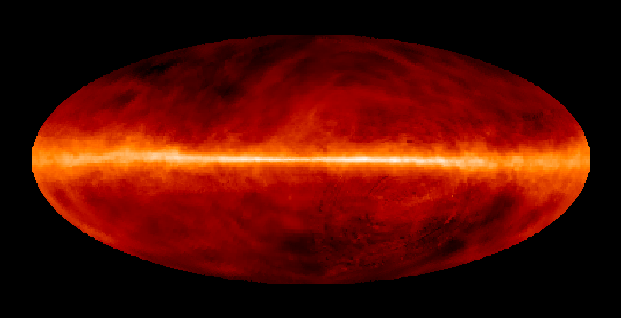
“Interstellar space is filled with extremely tenuous clouds of gas which are mostly Hydrogen. The neutral hydrogen atom (HI in astronomer's shorthand) consists of 1 proton and 1 electron. The proton and electron spin like tops but can have only two orientations; spin axes parallel or anti-parallel. It is a rare event for Hydrogen atoms in the interstellar medium to switch from the parallel to the anti-parallel configuration, but when they do they emit radio waves with a wavelength of 21 centimeters (about 8 inches) and a corresponding frequency of exactly 1420 MHz. Tuned to this frequency radio telescopes have mapped the neutral Hydrogen in the sky. The above image represents such an all-sky HI survey with the plane of our Milky Way Galaxy running horizontally through the center. In this false color image no stars are visible, just diffuse clouds of gas tens to hundreds of light years across which cluster near the plane. The gas clouds seem to form arching, looping structures, stirred up by stellar activity in the galactic disk."
Copyright: Public domain
#549 Comet Hale-Bopp Inbound
Credit: December 19, 1996

“Headed toward the inner Solar System, the much anticipated Comet Hale-Bopp has promised to put on a big show next spring. The comet's apparent brightness is currently approaching 4th magnitude and its inbound journey has been closely followed by many observers. But because it is now so near the Sun's position in the sky it is a difficult target for large ground based optical telescopes as well as the orbiting Hubble Space Telescope (HST). This series of HST images hints at the comet's evolution during the last year, illustrating active and quiescent phases. Hidden from direct view by the dusty cometary coma, Hale-Bopp's nucleus is centered in each frame. A single telescopic image of the comet has recently caused substantial activity on the internet based on false claims of the existence of a mysterious companion. However, the mystery guest turned out to be an 8th magnitude star! Many predict that by next spring telescopes large or small will not be needed to appreciate the true spectacle of Hale-Bopp as it blossoms into a naked-eye astronomical wonder."
Copyright: Public domain
Upvote! Resteem! Comment! As you like it! Thank you for attention!